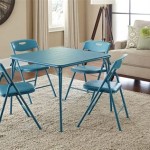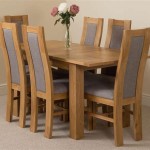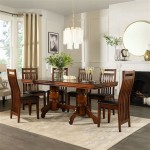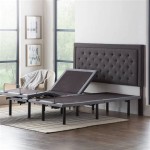Dining Room Table Counter Height: A Comprehensive Guide
When selecting a dining room table, one of the crucial decisions to make is the height. While traditional dining tables stand at a height of 28-30 inches, counter-height dining tables offer a unique alternative with a raised height of 34-36 inches. This elevated design provides several advantages and considerations that warrant careful examination.
Benefits of Counter-Height Dining Tables
Counter-height dining tables offer a number of benefits that make them a popular choice for many homeowners:
- Convenience: The raised height of counter-height tables makes them more convenient for use. You can easily transition from standing to sitting and vice versa, eliminating the need to stoop or reach down to the table.
- Versatility: Counter-height tables can serve multiple purposes beyond dining. They can be used as a work surface, a bar area, or even a kitchen island extension.
- Ergonomics: The elevated height of counter-height tables reduces strain on your back and legs, making them more comfortable for prolonged periods of sitting.
- Socialization: Counter-height tables promote a more casual and social dining experience. They encourage conversation and facilitate easier interaction between guests.
Considerations for Counter-Height Dining Tables
While counter-height dining tables offer advantages, there are also some factors to consider before making a decision:
- Chair Height: When selecting chairs for a counter-height table, it's important to ensure that they have the appropriate height. Look for chairs that have a seat height of 24-26 inches.
- Lighting: The raised height of counter-height tables can create challenges with lighting. Make sure to provide adequate lighting above the table to prevent shadows and glare.
- Space: Counter-height dining tables require more headroom than traditional tables. Be sure to measure the height of your ceiling and ensure there is sufficient clearance.
- Accessibility: Counter-height tables may not be suitable for all individuals, including children, elderly people, or those with mobility issues.
Comparing Counter-Height to Traditional Dining Tables
To help you make an informed decision, here is a comparison table highlighting the key differences between counter-height and traditional dining tables:
|Feature
|Counter-Height Dining Table
|Traditional Dining Table
| |---|---|---| | Height | 34-36 inches | 28-30 inches | | Convenience | Higher, easier to transition from standing to sitting | Lower, more traditional height | | Versatility | Can serve as a work surface, bar area, or kitchen island extension | Primarily used for dining | | Ergonomics | Reduces strain on back and legs | May require more effort to get in and out of chairs | | Socialization | Promotes a more casual and social dining experience | May be less formal and comfortable for long periods of sitting |Conclusion
Whether you choose a counter-height or traditional dining table ultimately depends on your preferences and the specific requirements of your dining space. By carefully considering the benefits and considerations of each type, you can make an informed decision that will enhance your dining experience.

Counter Height Dining Sets Lexington Overstock Warehouse

Myshanna Gray 6pc Counter Height Dining Set Lexington Overstock Warehouse

Gia Grey 5 Pc Counter Height Dining Room

Riverdale Driftwood 5 Piece Counter Height Dining The Dump Furniture Outlet

Dining Room Sets Dewey 5 Pc Counter Height Set At By

5 Piece Dining Table Set Wooden Counter Height Square With 4 Padded Chairs And 2 Tier Storage Shelves Kitchen Room

Counter Height Dining Room Table Haynes Furniture

Steve Silver Cm420wt Camila Counter Height Dining Room Set With Black Chairs

6 Piece Counter Height Dining Table Set With Shelf Espresso Aosom Com

Noreste 60 In Rectangle Gray Wood Counter Height Dining Table Seats 6








